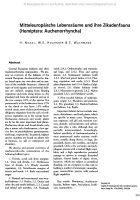Mitteleuropäische Lebensräume und ihre Zikaden (Insecta: Hemiptera: Auchenorrhyncha)

Abstract
Central European habitats and their Auchenorrhyncha communities – We present an overview of the habitats of the central European Auchenorrhyncha fauna, based upon our own data and an analysis of the available literature. Almost all types of semi-aquatic and terrestrial habitats are utilized, ranging from floating vegetation and reeds along shores to dry grassland and from the mineral soil up to the tree canopy. 61% of the species live permanently in the herbaceous layer, 27% in the shrub or tree layer. 11% utilize several strata, most of them performing an obligatory migration from the soil or herbaceous
vegetation up to the canopy layer. Herbaceous monocots and woody plants are by far the most important food plants. Herbaceous dicots and dwarf shrubs only play a minor role; furthermore, a few species live on pteridophytes, gymnosperms, and fungi, respectively. In general, highest species numbers are found on plants rich in biomass, i.e. tall or widespread and abundant.
We discuss and present overviews of Auchenorrhyncha communities of the following habitat types:
1. Forests, scrub and their margins: 1.1. Trees and shrubs, 1.2. Herbaceous layer of forests, 1.3. Woody riverside vegetation, 1.4. Xerothermic margins of forests and scrub, 1.5. Early successional stages.
2. Natural and near-natural non-wooded habitats: 2.1. Rocks, 2.2. Dunes and other dry and sandy habitats, 2.3. Coastal and inland salt marshes, 2.4. Peatlands (with 2.4.1. Ombrotrophic and transitional bogs, and 2.4.2. Fens and spring mires), 2.5. Semiaquatic habitats (with 2.5.1. Mud and gravel banks, 2.5.2. Floating vegetation and reeds, 2.5.3. Flood plain depressions and 2.5.4. Banks of alpine rivers), 2.6. Alpine habitats (with 2.6.1. Mountains in general, 2.6.2. Alpine grassland 2.6.3. and Subalpine scrub).
3. Non-wooded habitats of anthropogenic origin: 3.1. Meadows and pastures, 3.2. Dry grassland, 3.3. Ruderal habitats and fallows, 3.4. Fields.
Important habitat factors include moisture, disturbance, and food plants, which are specific in many cases. Temperature, sun exposure, soil pH and nutrient content, altitude, soil properties, and salinity may also play a role, although they are partially intercorrelated. Accordingly, habitat specificity of Auchenorrhyncha is most pronounced under extreme conditions, notably along shores, in bogs, dry grassland, dunes, salt marshes, and alpine grassland. Only a few eurytopic and polyphagous species with a marked flight capability and a high reproductive potential manage to survive in strongly disturbed habitats. Gravel banks of alpine rivers, however, which are subject to periodical flooding, are an exception to this rule in holding a number of stenotopic, monophagous, monovoltine species with reduced flight capability.
Keywords: Hemiptera, Auchenorrhyncha, habitat types, food plants, herbivore communities.
Download
Mitteleuropäische Lebensräume und ihre Zikaden (Insecta: Hemiptera: Auchenorrhyncha)


